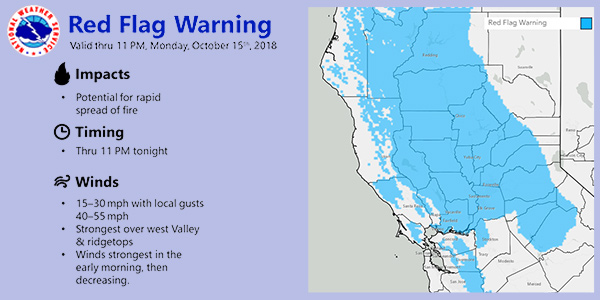By Hudson Sangree
SACRAMENTO — Pacific Gas and Electric pre-emptively shut down power to thousands of its customers on Sunday and Monday, one year after high winds toppled live utility lines and started wildfires that burned through large swaths of Northern California.
The shutdown happened during similar conditions to those that preceded the 2017 blazes. The National Weather Service issued a red-flag warning for the potential rapid spread of fires through 11 p.m. Monday. Wind gusts of up to 55 mph were predicted in the state’s coastal mountains and inland valleys. PG&E, which has installed 100 weather stations in fire-prone areas, said it also weighed factors that included low humidity, dry fuel on the ground and the low moisture content of live vegetation.
Up to 87,000 customers would be without power in mostly rural communities of the northern San Francisco Bay Area and the Sierra Nevada foothills, PG&E said in a news release Sunday.
“We have made the decision to turn off power as a last resort given the extreme fire danger conditions these communities are experiencing,” Pat Hogan, PG&E’s senior vice president of electric operations, said in the statement.
One major urban area, Santa Rosa, was also slated to have its electricity turned off. A significant part of the city was leveled in the Tubbs fire of October 2017, with 2,800 homes destroyed. The cause of that fire has yet to be determined.
PG&E is facing billions of dollars of liability for last year’s fires, many of which started after the company’s equipment came into contact with trees and other vegetation, according to the California Department of Forestry and Fire Protection.
Cal Fire most recently blamed PG&E equipment for starting the Cascade fire on Oct. 8, 2017, in Yuba County, saying in a news release, that “a high wind event in conjunction with the power line sag on two conductors caused the lines to come into contact, which created an electrical arc.” That fire killed four people, destroyed 264 structures and burned 10,000 acres.
The weekend shutdowns were meant to prevent additional blazes. The company said it would conduct line inspections after the winds had passed and restore power once it deemed conditions were safe.
The electrical shutdown was extraordinary for Northern California, although San Diego Gas & Electric has implemented similar measures in Southern California during recent fire seasons.
The northern part of the state experienced by far its largest fire ever this summer, when the Mendocino Complex of fires burned more than 400,000 acres in rugged terrain north of San Francisco. Previous fire records also were set in 2017 and 2016.
The State Legislature and Gov. Jerry Brown have been seeking ways to prevent wildfires. Proactive shutdowns were a major topic of discussion during discussions this year of SB 901, a wildfire prevention and liability-relief act for utilities.
The final measure, signed by Brown in September, requires electrical corporations to submit wildfire mitigation plans to the Public Utilities Commission. The plans must include “protocols for disabling reclosers and de-energizing portions of the electrical distribution system” as well as procedures for notifying customers. (See California Wildfire Bill Goes to Governor.)
Over the weekend, PG&E sent automated voice messages, texts and emails to customers alerting them to potentially extreme weather conditions with high wildfire danger starting Sunday evening and lasting through Monday morning.
PG&E’s automated call to potentially affected customers said: “Extreme weather conditions with high fire danger are forecasted in (county name), starting today and lasting through Monday morning. These conditions may cause power outages. To protect public safety, PG&E may also temporarily turn off power in your neighborhood or community. If there is an outage, we will work to restore service as soon as it is safe to do so.”



